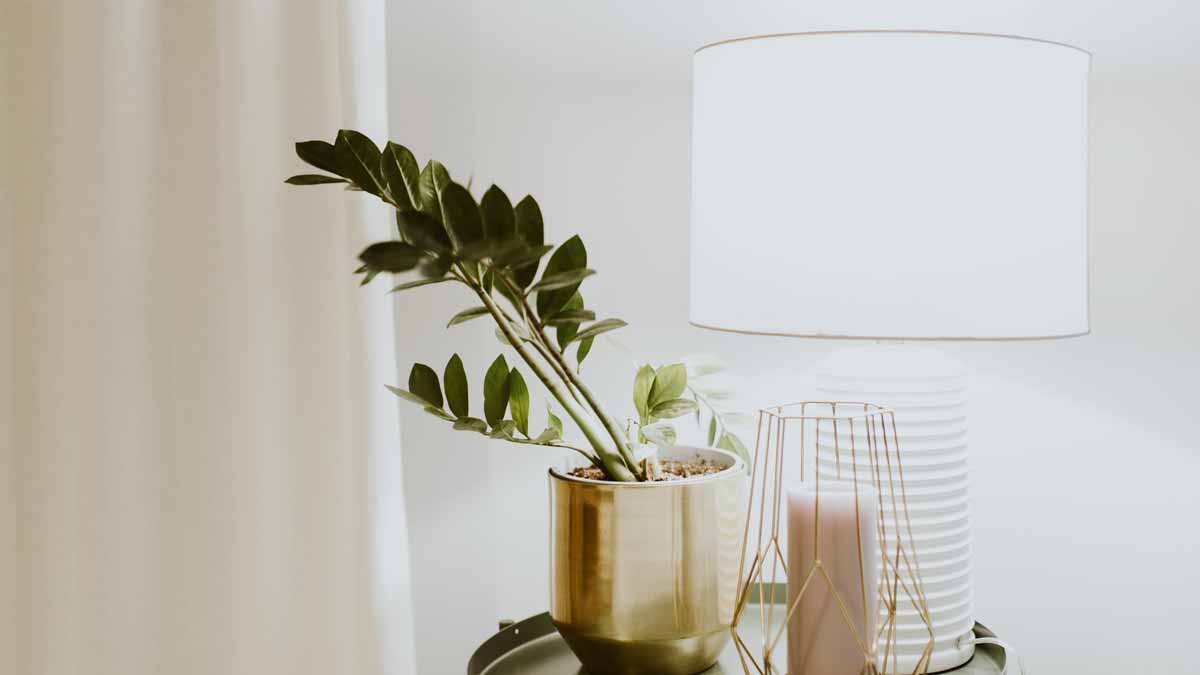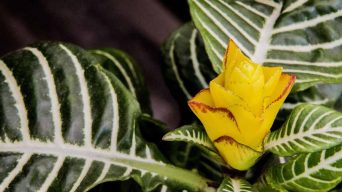ZZ plants can die due to various reasons like overwatering, underwatering, too much or too little sunlight, nutrient deficiencies, overfertilization, being root-bound, cold or heat damage, pest infestations, and diseases. To save a dying ZZ plant, identify the issue and take appropriate corrective actions.
ZZ plants (Zamioculcas zamiifolia) are known for being tough, easy-to-care-for houseplants.
But even the most robust plant can start to wilt and die if it’s not getting the proper care.
If your ZZ plant is looking less than perky, don’t despair!
There are several things you can do to save your indoor plant.
Why Is My ZZ Plant Dying?
There are a few reasons why your ZZ plant might be dying.
Here are some of the most common causes:
1. Overwatering
One of the most common reasons for a dying ZZ plant is overwatering.
ZZ plants need to be watered about once a week, and they like their soil to dry out completely between waterings.
If you’re watering your plant more often than that, or if the soil is always damp, it could be causing your plant to rot.
How To Tell If You’re Overwatering Your ZZ Plant
There are a few signs that you might be overwatering your plant:
- The leaves are wilting or turning yellow
- The leaves have brown or black spots
- The stems are soft or mushy
- The potting mix is always wet or soggy
- The roots are black or slimy
How To Save An Overwatered ZZ Plant
If you think you’ve been overwatering your plant, you first need to cut back on watering.
Allow the soil to dry out completely between waterings, and don’t water your plant more than once a week.
You need to inspect the roots to see if they’re damaged.
If the roots are black or mushy, you must trim them back and repot the plant in a fresh, dry potting mix.
2. Underwatering
While overwatering is one of the most common reasons for a dying ZZ plant, underwatering is also a problem.
ZZ plants need to be watered about once a week, and if you don’t water your plant often enough, it will start to suffer.
When a plant doesn’t get enough water, it cannot uptake the nutrients it needs from the soil, which can lead to a slow decline.
How To Tell If You’re Underwatering Your ZZ Plant
There are a few signs that you might be underwatering your ZZ plant:
- The leaves are wilting or drooping
- The leaves are dry or crispy
- The leaves are brown or black
- The potting mix is dry and crumbly
How To Save An Underwatered ZZ Plant
If you think you’re underwatering your plant, you must start watering it more often.
Water your plant deeply weekly, and ensure the potting mix is moist but not soggy.
Only water your plant when the potting mix is dry, and don’t let the pot sit in water.
3. Too Much Sunlight
ZZ plants do best in bright indirect light.
If your plant is getting too much sun, it can start to suffer.
Too much sun can cause the leaves to scorch or turn brown, making the plant wilt.
How To Tell If Your Plant Is Getting Too Much Sun
There are a few signs that your plant is getting too much sun:
- The leaves are yellow or pale
- The leaves are brown or black
- The leaves are wilting or drooping
- There are crisp or dry patches on the leaves
How To Save A Plant That’s Getting Too Much Sunlight
If you think your plant is getting too much sun, the best thing to do is move it to a spot with less sunlight.
ZZ plants need at least 4 hours of indirect sunlight a day, so try to find a spot where your plant will get some bright light without being in direct sun.
An east- or west-facing window is usually a good spot.
4. Not Enough Sunlight
While too much sun can be a problem for ZZ plants, so can not enough sun.
ZZ plants need at least 4 hours of indirect sunlight a day, and if they’re not getting enough light, they will start to suffer.
Not enough sunlight can cause the leaves to turn yellow or pale, making the ZZ plant stretch out and become leggy.
How To Tell If Your Plant Is Not Getting Enough Sunlight
There are a few signs that your plant is not getting enough sun:
- The leaves are yellow or pale
- The leaves are small or stunted
- The plant is leggy or stretched out
- The plant is not growing
How To Save A Plant That’s Not Getting Enough Sunlight
If you think your plant is not getting enough sun, the best thing to do is move it to a spot with more sunlight.
ZZ plants need at least 4 hours of indirect sunlight daily, so try to find a spot where your plant will get some bright light.
An east- or west-facing window is usually a good spot.
5. Nutrient Deficiencies
ZZ plants need a good quality potting mix that is high in nutrients.
If your plant is not getting the nutrients it needs, it can start to suffer.
The most common nutrient deficiency in ZZ plants is iron, which can cause the leaves to turn yellow or pale.
Other nutrient deficiencies can also cause problems for ZZ plants, so it’s essential to ensure your plant gets all the nutrients it needs.
How To Tell If Your Plant Has A Nutrient Deficiency
There are a few signs that your plant might have a nutrient deficiency:
- The leaves are yellow or pale
- The leaves are small or stunted
- The plant is not growing
- The plant is wilting or drooping
How To Save A Plant With A Nutrient Deficiency
If you think your plant might have a nutrient deficiency, the best thing to do is fertilize it.
Use a high-quality fertilizer high in nutrients, and fertilize your plant once a month during the growing season.
During winter, you can reduce the frequency to once every two months.
Be careful not to overfertilize your plant, as this can cause problems.
6. Overfertilization
While it’s important to fertilize your ZZ plant, it’s also essential not to overfertilize it.
When a plant is overfertilized, the roots can’t take up all the nutrients, and the excess nutrients can build up in the potting soil and start to burn the roots.
This can cause several problems for your plant, including yellow or brown leaves, wilting, and stunted growth.
How To Tell If Your Plant Is Overfertilized
There are a few signs that your plant might be overfertilized:
- The lower leaves are yellow or brown
- The leaves are wilting or drooping
- The leaves have brown tips or edges
- The plant is stunted or not growing
- The roots are white or covered in brown spots
How To Save An Overfertilized Plant
If you think your plant might be overfertilized, the best thing to do is flush the soil.
To do this, water your plant thoroughly until water starts to come out of the drainage holes.
Let the water sit for a few minutes, then water again.
Repeat this process until the water runs clear.
Once the soil has been flushed, don’t fertilize your plant for a few weeks to give it time to recover.
7. Root-Bound
When a plant becomes root-bound, the roots start to grow in a circle around the edge of the pot.
As the roots continue to grow, they start to strangle and suffocate each other, which can be fatal for the plant.
Root-bound plants can also be more susceptible to diseases and pests.
How To Tell If Your Plant Is Root-Bound
There are a few signs that your plant might be root-bound:
- The roots are growing out of the drainage holes
- The roots are circling the edge of the pot
- The plant is not growing
- The plant is wilting or drooping
How To Save A Root-Bound Plant
If you think your plant might be root-bound, the best thing to do is repot it.
Carefully remove the plant from its pot and loosen the roots.
You may need to trim some of the roots if they are too long or tangled.
Then, replant your plant in a new pot slightly larger than the previous one.
8. Cold Damage
ZZ plants are tropical plants, so they don’t tolerate cold temperatures well.
If your plant is exposed to cold temperatures, the leaves can turn brown and die.
ZZ plants thrive in temperatures that are between 60 and 85 degrees Fahrenheit.
If the temperature drops below 60 degrees Fahrenheit, it’s essential to take measures to protect your plant.
How To Tell If Your Plant Has Cold Damage
There are a few signs that your plant might have cold damage:
- The leaves are brown or wilted
- The leaves are drooping
- The plant is not growing
- The root ball is soft or mushy
How To Save A Plant With Cold Damage
If you think your plant might have cold damage, the best thing to do is move it to a warmer location.
If possible, move your plant indoors or into a greenhouse.
If you can’t move your plant, protect it from the cold by covering it with a frost blanket or burlap.
Ensure the plant receives indirect sunlight, as direct sunlight can further damage cold-damaged leaves.
9. Hot Temperatures
ZZ plants are native to Africa, where the climate is hot and humid. They will not tolerate temperatures below 50 degrees Fahrenheit and start to experience leaf drop when exposed to sustained periods of heat above 90 degrees.
The plant leaves will turn brown and wilt when the temperature gets too high.
How To Tell If Your Plant Has Heat Damage
There are a few signs that your plant might have heat damage:
- The leaves edges are brown or crispy
- The leaves are wilting or drooping
- The plant is not growing
- The plant is shedding leaves
How To Save A Plant With Heat Damage
If you think your plant might have heat damage, the best thing to do is move it to a cooler location.
If possible, move your plant indoors or into a shady spot outdoors.
If the temperature is too high for your plant to be moved, you can try misting it with water or placing a fan near it.
Ensure the plant has good air circulation and is not in direct sunlight.
Once the temperatures start to cool down, your plant should recover.
10. Pest Infestation
Pests can be a big problem for ZZ plants.
Common pests that attack ZZ plants include mealybugs, spider mites, and scale insects.
Mealybugs are small, white insects that feed on plant sap.
Spider mites are tiny spider-like creatures that suck the juice out of plants.
Scale insects are small, hard-shelled bugs that attach themselves to plants and suck out the sap.
Pests can cause a lot of damage to ZZ plants, including leaf drop, stunted growth, and yellowing leaves.
How To Tell If Your Plant Has Pests
There are a few signs that your plant might have pests:
- The leaves are covered in white fuzzy stuff
- The leaves are covered in tiny red or brown dots
- The leaves are wilting or drooping
- The leaves have holes
- The plant is not growing
How To Save A Plant With Pests
If you think your plant might have pests, you should first isolate it from other plants.
This will prevent the pests from spreading to your other plants.
Then, you can try treating the plant with insecticidal soap or neem oil.
You can also try making a homemade pest spray by mixing 1 part rubbing alcohol with 9 parts water.
Spray the plant with the pest spray and get the undersides of the leaves.
You may need to treat your plant multiple times to get rid of all the pests.
11. Diseases
A few diseases can affect ZZ plants, including root rot and leaf spot.
ZZ plant root rot is caused by too much water. The roots of the plant start to decay, and the plant will eventually die.
Fungi or bacteria cause leaf spot. The ZZ plant leaves will start to turn yellow or brown and eventually fall off.
How To Tell If Your Plant Has A Disease
There are a few signs that your plant might have a disease:
- The leaves are turning yellow or brown
- The leaves are falling off
- The leaves have brown or black spots
- The stem is soft or rotting
- The plant is not growing
How To Save A Plant With A Disease
If you think your plant might have a disease, you should first isolate it from other plants.
This will prevent the disease from spreading to your other indoor plants.
Remove any infected leaves and dispose of them.
Then, you can try treating the plant with a fungicide or bactericide.
You can also try making a homemade fungicide by mixing 1 tablespoon of baking soda with 1 quart of water.
Spray the plant with the fungicide and cover all the leaves.
You may need to treat your plant multiple times to get rid of all the disease.
Final Thoughts
Zamioculcas zamiifolia are tough plants that can withstand a lot of abuse.
However, they are not invincible and can die if not cared for properly.
If your ZZ plant is dying, the best thing to do is try to figure out what is causing the problem and then take steps to fix it.
Most of the time, with a little bit of care, you can save your plant.







